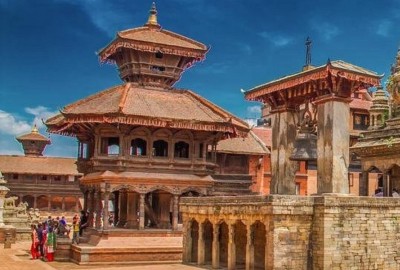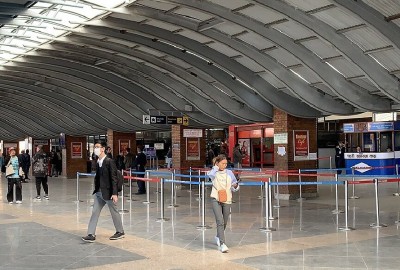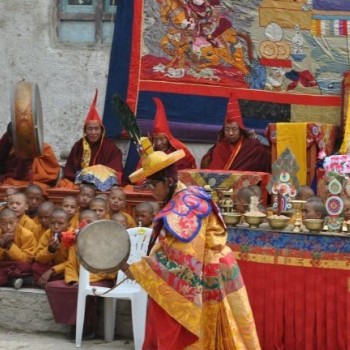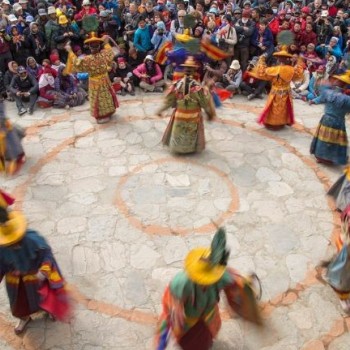In Nepal's Mustang District, Upper Mustang is a mysterious haven tucked away in the rain shadow of the Annapurna and Dhaulagiri mountains of the Himalayas. The "Forbidden Kingdom," as this isolated and restricted area is sometimes called, preserves a distinctive fusion of Tibetan culture and scenery. The old customs and manner of life have been largely spared from modernization because of its seclusion.
Table of Contents
Plan your trip to Nepal
Customize your trip with help from a local travel specialist.
The rough topography of Upper Mustang is made up of deep gorges, towering cliffs, and wide stretches of desolate desert-like scenery interspersed with verdant oasis settlements. Lo Manthang, an old walled city that embodies the region's rich cultural legacy and rich history, is one of the highlights of Upper Mustang.
Upper Mustang's population is mostly of Tibetan origin, and their deep attachment to Buddhism is demonstrated by the many monasteries, chortens, and prayer flags that can be found all over the place. A glimpse into a very traditional way of life is provided to visitors by the warm smiles and welcoming nature of the residents, as well as by their colorful festivals.
Tiji Festival
The native inhabitants of Upper Mustang, an area tucked away in Nepal's far-flung reaches of the Himalayas, celebrate the colorful and culturally significant Tiji Festival, also known as Tenchi Festival. The celebration has great religious and historical significance for the Mustang people, who are primarily Buddhists from Tibet.
Usually held in May, the Tiji Festival spans three days and is distinguished by vibrant rituals, dances, and religious ceremonies. The festival honors the triumph of good over evil and revolves around the story of Dorje Jono, a god who fought a demon to prevent the fall of his kingdom.
In the old walled city of Lo Manthang, the capital of Upper Mustang, traditional dances known as "chaams" are performed by monks dressed in extravagant costumes and masks to start the festivities. Buddhist tales and teachings are communicated through these dances in addition to being a form of creative expression.
The "Chasing of the Demons" ceremony, one of the highlights of the Tiji Festival, sees dancers disguised as demons represent the forces of negativity, only to be defeated by the deity Dorje Jono, represented by another masked dancer. This symbolic conflict is thought to bring blessings and prosperity to society by symbolizing the victory of virtue over vice.
Locals dress traditionally for the event, and they congregate to pray, give sacrifices, and get blessings from the senior lamas of the monastery. To celebrate feasts, cultural events, and other customs, the entire community gathers together, strengthening their bonds of solidarity.
In addition to being a religious occasion, the Tiji Festival holds great cultural significance for the people of Upper Mustang, having been passed down through the years. It acts as a reminder of their rich cultural heritage, tenacity in the face of hardship, and history.
The Tiji Festival has drawn visitors in recent years who are looking to experience Upper Mustang's distinctive blend of spirituality, culture, and adventure. Nonetheless, measures are taken to protect the festival's spirit and sanctity while honoring the locals' traditional sensibilities and values.
Tiji Festival Celebration
The First Day
At noon, the Tiji Festival's first day officially begins. Throughout the day, the villagers get ready for the event to begin. The event starts with powerful horn sounds from the Dhungchen, Tibetan horns, double-reeled horns, drums, and cymbals.
Comprising of local performers and monks, the entourage starts at the monastery. After arriving at the square, the monks take a seat beneath the enormous Thangka, or painting, that is hanging on the southern wall. Following this, the "Tsa Chaam" masked dance begins. This dance with a mask narrates the tale of Dorje Jono's triumph over evil.
The Second Day
On the second day of the celebration, monks perform the "Nga Cham" dance. Stories about Dorje Jono's attempt to bring the demon back to the Buddha realm are told on the second day. Female performers emerge onto the main square dressed in traditional clothing and jewelry for the show. The primary practice showcasing the generation of celestial mansions and deities is the performance on the second day.
The Last Day
The performance concludes on the third day of the Tiji Festival. It starts with ceremonial music and ends with the "Rha Chaam," a masked dance. The show emphasizes the defeat of evil while this dance has a lively pace.
At the conclusion of the performance, all of the artists emerge, and the scene is filled with more dancing, music, and gunfire. An effigy made of Tsampa (barley), which symbolizes the monster "Ma Tam Ru Ta," is thrown by the monk who performs Dorjee Sonam.
Trek Route of Tiji Festival
The journey usually starts in Jomsom, a town in the southernmost point of the Mustang region, which is reachable from Pokhara either by a quick flight or a multi-day hike across the Annapurna range. Trekkers begin their adventure into the heart of Upper Mustang with a picturesque ascent from Jomsom.
The road meanders over arid but breathtaking scenery that is reminiscent of the Tibetan Plateau, complete with sheer cliffs, narrow ravines, and eroded canyons. Trekkers see traditional Tibetan communities along the route, complete with whitewashed buildings, historic temples, and vibrant prayer flags waving in the breeze.
Trekkers discover the region's rich cultural legacy, which has mostly escaped modernization, as they make their way through the dry terrain. Tibetan-born residents of Upper Mustang have long maintained their distinctive way of life, including their language, customs, and religious rituals.
Tiji Festival’s Cost and Permit
It is imperative to secure the required permits before starting the Tiji Festival Trek. According to my most recent update, the following permits are needed for this trek:
TIMS (Trekkers' Information Management System) card
All trekkers in Nepal are required to have this card. It guarantees trekkers' safety and aids with law enforcement's tracking of them. Whether you are walking independently or with a recognized trekking agency will determine the TIMS card cost.
ACAP (Annapurna Conservation Area Permit)
Trekkers must obtain this permit because the Tiji Festival Trek is located within the Annapurna Conservation Area. The region's natural and cultural resources are to be preserved by the ACAP. The price of the ACAP permit also differs based on your country of residence and whether you are hiking alone or with a group.
Special Resitricted Permit
As the Upper Mustang is a restricted area, visitors must obtain a special permit in order to access it. The cost of obtaining this permission varies according to how long you plan to stay in the area and is handled by a recognized trekking firm.
Government regulations can cause permit charges to change, so it's important to get the most recent details before organizing your hike. For the Tiji Festival Trek, other costs to take into account, aside from permit fees, are travel to and from the trekking starting point (often Pokhara or Jomsom), lodging along the way, meals, guide and porter fees (if applicable), and other incidentals.
Altitude Sickness during Tiji Festival Trek
Trekkers and climbers may have major concerns about altitude sickness, commonly known as acute mountain sickness (AMS), particularly while embarking on high-altitude activities such as the Tiji Festival Trek in Nepal's Mustang area. The well-liked Tiji Festival Trek culminates with the colorful Tiji Festival observed by the local Tibetan people, and it passes through some of the most stunning Himalayan scenery.
When the body cannot adjust to the dropping oxygen levels as altitude rises, altitude sickness develops. The symptoms, which might vary in severity, can include headaches, nausea, lightheadedness, exhaustion, and dyspnea. If treatment for altitude sickness is delayed, severe instances may result in high altitude cerebral edema (HACE) or high altitude pulmonary edema (HAPE), both of which can be fatal.
Most of the time, the Tiji Festival Trek takes hikers over 3,000 meters (9,842 feet), with certain sections of the track going as high as 4,000 meters (13,123 feet). Therefore, hikers must be aware of the hazards related to altitude sickness and adopt the appropriate safety measures to reduce them.
Gradual acclimatization is one of the most crucial strategies for avoiding altitude sickness. Trekkers should go up gradually so that their bodies can get used to the lower oxygen levels. Before ascending to greater altitudes, it is advised to stay at intermediate altitudes for a few days to allow the body to make more red blood cells and adjust to the decreased oxygen content.
Staying hydrated is essential when at high altitudes. Trekkers should keep well-hydrated because dehydration can make altitude sickness symptoms worse. Avoiding caffeine and alcohol can also help minimize dehydration and other discomforts associated with altitude.
The ability to identify the signs of altitude sickness and know when to return is another crucial component of prevention. As soon as symptoms like intense headaches, nausea, disorientation, or trouble breathing appear, you must promptly descend to a lower altitude. More serious problems may arise from pushing through or ignoring symptoms.
The Tiji Festival Trek requires participants to have appropriate gear, such as warm clothing and supportive shoes, because the Himalayan weather can be unpredictable, particularly at higher elevations.
While altitude sickness can be a worry, trekkers can reduce the hazards and fully enjoy the breathtaking grandeur of the Tiji Festival Trek and the cultural richness of the Tiji Festival itself with appropriate planning, progressive acclimatization, and careful monitoring of symptoms.
Key Information while Travelling in the Upper Mustang Region
Typically, the Tiji festival takes place in May, which is a pleasant time to visit the Upper Mustang region. In addition, the ideal seasons—spring and fall—offer easily accessible weather, good visibility, and mild days.
In Nepal, springtime arrives in March and lasts until the middle of May, while fall arrives in mid-September and lasts until November. Because Upper Mustang is located in a rain shadow, it is accessible all year round. It is challenging to complete the hike in the winter, though, because the area receives bitterly low temperatures from December to February.
Mustangs can be reached in two different ways: via air and land. Almost every day, a 25-minute flight departs from Pokhara Airport. The journey to Jomsom via trans-Himalayan flight offers breathtaking views of the Kali Gandaki Gorge, Machhapuchhre, and the Annapurna Massif from above.
Alternatively, one can rent a jeep from Pokhara and go about 155 miles to Jomsom. After Beni Highway, the road leads to Jomsom. Along the Kali Gandaki River, the trail climbs upstream from this point. You will be able to see the breathtaking Rupse Waterfall and Kali Gandaki Gorge.
Throughout the path, there won't be any places to charge electronic devices. Many teahouses have solar panels installed in order to permit year-round electrical supply. The trek requires hikers to bring extra batteries and power banks.
With the exception of a few communities like Jomsom and Kagbeni, the lodging offered during the journey is rather poor. Nearly all of the trail's accommodations provide shared bathrooms and twin bed sharing options.
Before starting the Tiji Festival Trek, hikers are required to purchase travel insurance. While there are very few incidents of missing persons, emergency evacuations, or rescues in the Upper Mustang region, hikers should nevertheless exercise caution before starting this journey.
To be ready for this expedition, one can engage in running, trekking, and other stamina-building exercises. On a warm day, walking across kilometers of wide, desolate terrain can frequently become challenging. Thus, it is generally helpful to prepare the body and mind in advance of the walk.
The Upper Mustang Trail demands the bare minimum of equipment and gear for trekking. In Kathmandu, essential gear and equipment such as trek boots, thermals, down coats, sunglasses, and more can be bought or rented.

.png)








